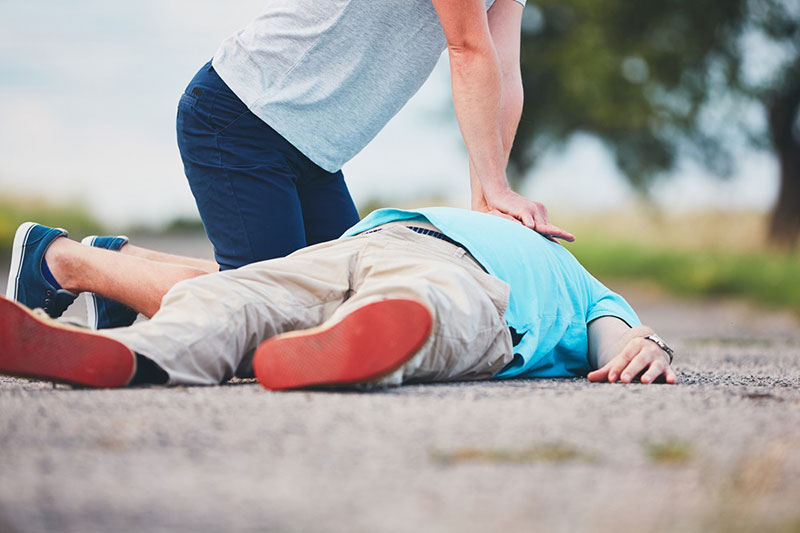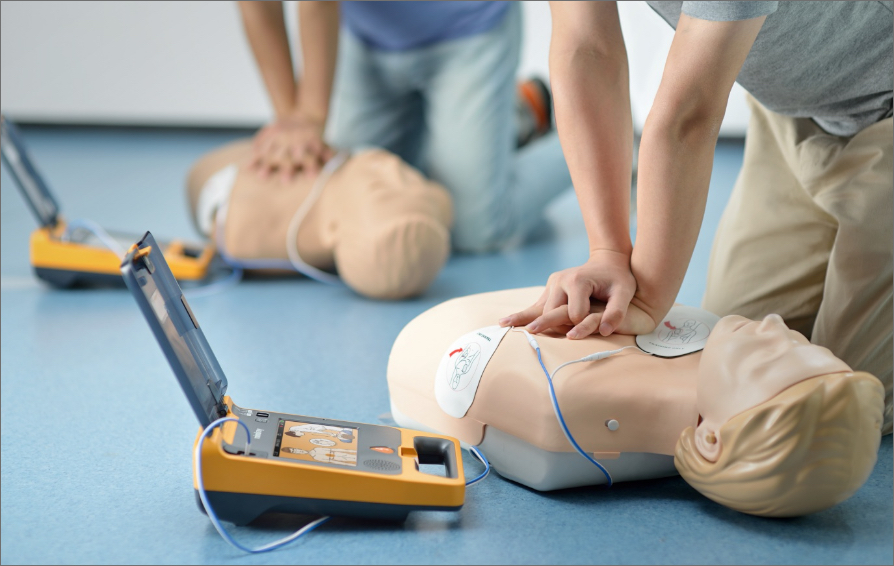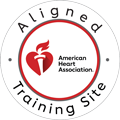I. Introduction
Sudden cardiac arrest (SCA) is a medical emergency where the heart unexpectedly stops beating, cutting off blood flow to the brain and other vital organs. It can happen to anyone, at any time, and without immediate intervention, the chances of survival drop dramatically with each passing minute. This is why acting quickly is critical when someone experiences a cardiac arrest.
Two life-saving techniques are commonly discussed in such situations: Cardiopulmonary Resuscitation (CPR) and an Automated External Defibrillator (AED). Both can significantly increase a person’s chances of survival, but many people wonder: Which should you use first?
This article aims to clarify the roles of CPR and AED in emergencies, explore how these two techniques work together, and provide guidance on when to prioritize each. By understanding their functions and when to apply them, you can be better prepared to act in a life-threatening situation.

II. Understanding CPR (Cardiopulmonary Resuscitation)
CPR, or Cardiopulmonary Resuscitation, is a life-saving technique designed to maintain circulation and oxygenation in a person whose heart has stopped. When the heart stops beating, the flow of oxygenated blood to the brain and other vital organs is interrupted, leading to permanent damage or death if untreated. CPR helps by manually pumping the heart through chest compressions, sustaining a minimal flow of oxygenated blood until more definitive treatment, such as defibrillation or advanced medical care, can be applied.
The Basics of CPR
CPR consists of two main actions:
Call Us Now
Get the Best CPR Class in Kansas City Today!
- Chest Compressions: Pressing down firmly and rapidly on the chest to mimic the heart’s pumping action. The goal is to restore partial blood flow to the brain and organs.
- Rescue Breaths (Optional in Some Cases): Providing mouth-to-mouth breaths to supply oxygen directly to the lungs. In some cases, especially in hands-only CPR, breaths may not be required, with emphasis placed solely on compressions.
When Should You Perform CPR?
CPR should be initiated as soon as it is determined that a person is unresponsive and not breathing, or if they are gasping for air (a sign of agonal breathing, which can occur during cardiac arrest). Immediate chest compressions keep blood circulating to vital organs until emergency responders arrive or an AED is available to deliver a shock that may restart the heart’s rhythm.
Why Is CPR Important?
Every minute that passes without CPR during cardiac arrest reduces the chance of survival by 7% to 10%. Starting CPR right away ensures that oxygen continues to reach the brain and other vital organs, buying critical time until more advanced help arrives or an AED is used. Without CPR, a person experiencing cardiac arrest may die within minutes.
In short, CPR is your immediate response to a cardiac emergency, keeping the person alive long enough for further treatment. Its simplicity, effectiveness, and ease of learning make it one of the most critical life-saving techniques anyone can perform.
III. Understanding AED (Automated External Defibrillator)
An Automated External Defibrillator (AED) is a portable device used to treat sudden cardiac arrest (SCA) by delivering a controlled electric shock to the heart. Its purpose is to restore the heart’s normal rhythm, particularly in cases where the heart has gone into a chaotic, irregular rhythm called ventricular fibrillation (VF) or ventricular tachycardia (VT). Both VF and VT are life-threatening rhythms that prevent the heart from pumping blood effectively.
How Does an AED Work?
The AED works by analyzing the heart’s electrical activity and determining whether a shock is necessary. Here’s how the process typically works:
- Turn on the AED: Most AEDs are designed to be user-friendly, with visual and verbal prompts guiding the user through the process.
- Attach the Pads: Two adhesive pads are placed on the person’s bare chest, usually one on the upper right side and the other on the lower left side. These pads help the AED monitor the heart’s rhythm.
- Analyze the Heart Rhythm: Once the pads are attached, the AED automatically checks the heart’s electrical activity. If the AED detects an abnormal rhythm, such as ventricular fibrillation, it will recommend a shock.
- Deliver the Shock (if needed): If a shock is advised, the device will prompt the user to press a button to deliver the shock. The electrical pulse temporarily stops all electrical activity in the heart, allowing it to reset and restore a normal rhythm.
When Should You Use an AED?
An AED should be used as soon as it’s available in cases of suspected cardiac arrest, especially if CPR is already in progress. Time is crucial during cardiac arrest, and the sooner the heart can be restarted with an electric shock, the higher the chances of survival. Ideally, the AED should be applied within 3-5 minutes of collapse.
Why Is an AED Important?
While CPR helps maintain blood flow, it does not restart the heart in most cases of cardiac arrest caused by an electrical problem. The AED is critical because it can correct these life-threatening heart rhythms, something CPR alone cannot do. According to the American Heart Association, if defibrillation is provided within the first few minutes, survival rates can be as high as 70%.
One of the key advantages of modern AEDs is that they are designed for use by non-medical personnel. Public places like airports, schools, gyms, and shopping malls often have AEDs available, and the device itself gives clear, step-by-step instructions, making it easy for bystanders to use in an emergency.
In summary, the AED is a powerful tool for restoring a normal heart rhythm in someone experiencing sudden cardiac arrest. Its combination with CPR offers the best chance for survival in a cardiac emergency.

IV. The Relationship Between CPR and AED
CPR and AED are complementary tools used to improve survival rates in cases of sudden cardiac arrest (SCA). While both techniques serve different purposes, they work hand-in-hand to keep the person alive until professional medical help arrives. Understanding how and when to use each is critical for effective emergency response.
CPR Maintains Blood Flow
CPR focuses on maintaining circulation when the heart stops beating. Chest compressions help push oxygenated blood to the brain and other vital organs, which is essential in preventing brain damage and keeping the person alive. However, CPR does not directly address the root cause of cardiac arrest, especially if it is due to an irregular heart rhythm.
This is where CPR acts as a “bridge” to more definitive treatment. By performing chest compressions, you are effectively buying time, keeping the heart and brain supplied with blood until the AED can be used or emergency medical services arrive.
AED Restores Heart Rhythm
The AED, on the other hand, addresses the underlying issue causing the cardiac arrest. In many cases of cardiac arrest, the heart experiences an electrical malfunction that leads to ventricular fibrillation (VF) or ventricular tachycardia (VT). These irregular rhythms prevent the heart from pumping effectively, which leads to a lack of blood flow.
While CPR helps maintain circulation, it is the AED that can deliver the electrical shock necessary to reset the heart’s rhythm and restore normal heart function. Without the AED’s ability to correct an irregular rhythm, CPR alone is often not enough to save the person.
Using Both CPR and AED Together
CPR and AED are most effective when used together, and as quickly as possible. In an ideal scenario:
- CPR is started immediately when someone is found unresponsive and not breathing. This maintains blood flow and increases the likelihood of a positive outcome.
- An AED is applied as soon as it’s available. Once the AED is ready, it will assess the heart’s rhythm and determine whether a shock is needed. CPR should be paused momentarily while the AED evaluates the heart.
If a shock is advised, the AED will guide the user to deliver the shock, after which CPR should resume immediately until either the person regains consciousness or emergency responders arrive.
Statistics on Survival Rates
Studies have shown that survival rates increase significantly when both CPR and AED are used promptly. For example, survival rates for out-of-hospital cardiac arrests can double or even triple when a bystander provides immediate CPR and an AED is used within the first few minutes. The combination of early CPR and defibrillation is crucial in improving outcomes.
V. CPR vs AED: Which Should You Use First?
When faced with sudden cardiac arrest, it’s critical to act quickly and decisively. The natural question many people ask is: Should I start CPR or use an AED first? The answer depends on the situation, but general guidelines can help prioritize your actions.
Initial Assessment
Before starting CPR or using an AED, a quick assessment is necessary:
- Check Responsiveness: Tap the person and shout to see if they respond.
- Check Breathing: Look for normal breathing (not gasping or irregular). If the person is unresponsive and not breathing, you’re likely dealing with cardiac arrest.
- Call Emergency Services: Dial your local emergency number (e.g., 911) or have someone else do so. They can dispatch help and guide you through CPR if necessary.
Once it’s confirmed that the person is in cardiac arrest, you need to begin the next steps.
Start CPR Immediately
The priority is to begin chest compressions if the person is unresponsive and not breathing. CPR should begin right away because every second counts in maintaining blood flow to the brain and vital organs. You should start CPR immediately unless an AED is immediately available.
- Why CPR first?: The heart is no longer pumping blood effectively, and chest compressions help sustain circulation. Without CPR, brain damage can occur within minutes. By maintaining blood flow, CPR buys time for the AED to arrive or for emergency responders to take over.
Use the AED as Soon as Possible
While CPR is crucial for keeping the blood circulating, using an AED is just as important in restarting the heart. If an AED is available, it should be applied as soon as possible. Here’s how to decide:
- If an AED is nearby: Send someone to retrieve it while you perform CPR. As soon as the AED arrives, apply it and follow the device’s instructions.
- If you’re alone: Start CPR immediately. Only stop CPR to use the AED if it’s within reach and can be applied quickly.
Once the AED is attached, it will analyze the heart’s rhythm and determine if a shock is needed. If the device advises a shock, make sure no one is touching the person, and then deliver the shock by pressing the button on the AED. After the shock, resume CPR until emergency services arrive or the person shows signs of responsiveness.
When to Prioritize the AED First
In rare cases, the AED may take priority over CPR if:
- An AED is immediately at hand: If you can apply the AED within seconds, doing so may take priority over starting CPR. The AED will analyze the heart’s rhythm and potentially restart the heart more quickly than CPR can sustain blood flow.
- Trained responders arrive with an AED: If medical professionals or someone trained in AED use arrive on the scene with the device, let them take over, and you can continue assisting with CPR if needed.
Key Takeaway: Use Both ASAP
The combination of both CPR and AED is what saves lives. CPR should begin first in most situations to maintain blood flow, and the AED should be applied as soon as it is available. The quicker both are applied, the better the outcome.
In summary:
- Start CPR immediately if someone is unresponsive and not breathing.
- Use the AED as soon as possible, whether that means sending someone to get it while you perform CPR or applying it yourself if it’s within reach.
- Continue CPR and follow the AED prompts until professional help arrives or the person regains consciousness.


